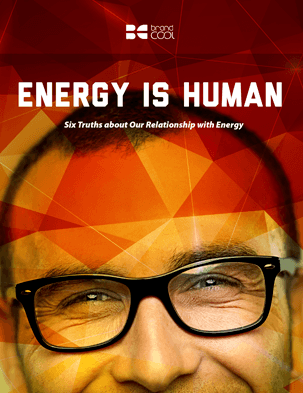Image by nicksumm via Morguefile
By Renee Lertzman and Sue Kochan
This article is adapted from the book Energy Is Human.
Energy efficiency programs continue to set increasingly ambitious savings targets. But the tactics taken to hit those targets are slow to evolve, and more often than not, programs are falling short. We've been working with clients for years to solve this problem, and we see a core underlying issue: typical efforts to promote energy efficiency focus narrowly on specific concerns -- namely, saving money or receiving incentives.
Many of these programmatic efforts are based on the assumption that if people received the benefits and incentives, they would shift their attention and change behaviors. Our experience -- along with emerging social science research -- tells us that these approaches aren't compelling for most people. They just don't work.
It's time we place energy within an emotional context, recognizing that it is something that's personal, intimate, and often below our consciousness. We need to apply this thinking to how we engage people around energy use, behavior change, and consumption.
In short, we need to think more like brand strategists and social scientists, and less like utilities and engineers. Purveyors of energy efficiency now have the opportunity to do this by crafting rich, dimensional communications designed to appeal to the whole person -- what we call a deeply human approach.
Creating the shift to a human-centered approach
People need more than a logical rationale for change. They need an emotional connection to highlight the presence of energy in their lives, and only then can they adapt to new ways of thinking about and using it. They need human insight.
Human insight is a deep understanding of how people process information, manage change, rely on social influences, and experience emotions. What follows is our take on emerging insights from the social sciences and industry -- where we see the innovation heading in the field of energy efficiency engagement.
Truth no. 1 - Information can -- and should -- be emotional
"People just don't really care about saving energy. How do we get them to care?" Does this sound familiar? Recent research (Ehrhardt Martinez et al 2010; Malone et al 2013) shows that, when it comes to using energy, consumption behaviors are rarely informed by rational, calculated information processing, such as saving costs or "doing the right thing." Instead, they are rooted in largely unconscious motivations such as the need to feel safe, secure, accepted, loved, free, and in control.
When discussing energy efficiency, many people find it hard to get past the word "efficiency" -- which is often associated with deprivation, loss, or going without. Our task is to address these concerns directly and not skirt around them. If people bristle at the thought of "going without," no matter how smart or informative a campaign is, it will come up against resistance -- until we hit these realities head-on.
Putting it into practice:
Don't rely on information alone to do the trick. Energy efficiency engagement programs, tools, and messaging should avoid relying on information laden tactics such as emails, and one-dimensional awareness-raising campaigns. Rather, more holistic approaches leverage underlying motivators for behaviors: purpose, mastery, and autonomy (c.f. Pink, 2009).
This means creating opportunities for people to genuinely engage: asking for input and contributions, connecting with the larger context and objectives (such as being part of an energy-smart future, community or state) allowing people to engage on their own terms (more customizable packages and options), and speaking directly to where people may be feeling most anxious, ambivalent, or aspiring (otherwise known as the "Three As" [Lertzman, 2014]).
Truth no. 2: Incentives create instant gratification, not lasting change
Incentives can create short bursts of change -- a quick uptick in activity or sign-ups. However, the "reward" from incentives fades quickly.
The problem with an over-reliance on incentives is twofold.
First, as Daniel Pink points out in Drive, incentives can backfire in that they indirectly suggest that whatever is being incentivized is so unsavory that people wouldn't do it on their own: it requires a reward or "prize" to sweeten the deal. Incentives play on external motivations (driven by the pursuit of rewards), which are short-lived and superficial, versus internal motivations (pertaining to individuals' values, purpose, or mission), which are deeply human with the power to engage, influence purchase decisions, and ultimately create lasting changes in understanding, attitude, and behavior.
Second, as Pink notes, the most powerful drivers for behaviors concern our needs for autonomy, mastery, and purpose. How often are these drivers used within energy efficiency programs? Rarely. For example, messaging that speaks directly to our inherent desire to be smarter, wiser, more capable (as parents, caregivers, and professionals), and part of a growing movement can actually unlock those innate capacities and desires, and help bring in people along the way.
Putting it into practice:
Present incentives as one of many perks. Incentives play an important role in most energy efficiency programs but should be used and communicated about judiciously and skillfully in the context of a more comprehensive engagement approach. When we reach out to any audience, incentives should be presented as one element in a tapestry of functional and emotional benefits programs have to offer.
Truth no. 3: Energy isn't abstract. It's what makes everyday life possible
The topic of energy is hardly on people's minds until it's either disrupted or in short supply. Connecting energy with the fabric of our daily lives through story, narrative, context, and conversation makes it more real and tangible.
How we talk about energy use needs to always come back to the impact this has on people's lives in a direct and down-to-earth way. Making energy visible through energy-use dashboards are powerful but not enough. The data is only meaningful when we connect the dots and ground it in the context of everyday life (for example, being able to control energy costs or using energy wisely by sharing what we don't use).
Putting it into practice:
Don't talk about saving energy as "little things you can do." It's about "everything you do." Appreciating energy means acknowledging that it makes our lifestyles, in their entirety, possible. If we replace "energy consumption" with "how we live," we meet people where they already are, and move from from an abstract topic to a more meaningful engagement.
Truth no. 4: Conversations convert
In our work with energy efficiency programs, we've observed a simple truth again and again: human interaction trumps all else when it comes to truly shifting behaviors around energy consumption.
We actually process information more effectively through personal stories, shared experiences, and conversation (Wheatley, 2014). This means having the ability -- live in person or otherwise -- to ask questions, get immediate feedback, and process all of those nonverbal cues that are so powerful when people come together and talk, particularly about a new topic or behavior change. It takes energy efficiency out of the abstract realm of attitudes, values, and beliefs, and into the more tangible, emotional area of direct experience, allowing people to see how new energy practices make sense in the context of their own lives.
Putting it into practice:
While awareness-focused tactics like email campaigns are important (broad-based awareness is critical when seeking to inspire a large group of people to do something new), simple human interaction -- engaging with people -- can go a very long way toward solidifying action.
Truth no. 5: Individuals have (and demand) more control than ever
People are increasingly used to being in the driver's seat of their lives. As consumers, we have tremendous opportunities to make choices -- in how or where we shop, the media we consume, and the direction we take with our jobs and careers. It's no surprise that contemporary research continues to reinforce the need to provide people with flexibility and control in their energy consumption as well -- and that new offerings are providing unprecedented energy choices. We need to leverage this factor as we explore ways to maximize the adoption of energy efficiency behaviors.
People need to feel and exercise creative influence on our world-including our work and life within the office. So when we come along and suggest people do something different, we need to be prepared for resistance, which can take the form of ignoring, denying, dismissing, or focusing on barriers to taking action. This is one of the greatest challenges in this work -- and why we need to shift how we approach and engage with people.
Putting it into practice:
Show efficacy through feedback. Of the more well-known ways to show efficacy is what's referred to as "feedback"-- devices, communications, and platforms that make our specific energy behaviors visible. This allows people to self-regulate, exercising considerably more autonomy over their behaviors. Psychologically, this is hugely significant; we relate to practices differently when being told to (think nagging) than when we are choosing on our own (creative choice). Whether we are tracking our footsteps via FitBit or monitoring our energy using a tool like Nest, feedback can be a powerful motivational tool.
Provide options. Feedback mechanisms are not the only game in town when it comes to tapping people's need for autonomy and control. Programs and initiatives can be designed far more flexibly to allow people to select, on their terms, how they wish to participate. Allowing for more control makes people feel like participation is on their terms, leading to a more positive association and deeper engagement.
What a deeply human approach to energy efficiency means
We are in the midst of a paradigm shift when it comes to how we promote energy efficiency programs. With growing insight into the psychological dimensions of energy efficiency, new opportunities are arising to engage our audiences with energy on a deeper, more emotional level than ever before.
Can people come to love energy programs like their favorite consumer brands? Yes. But only if the programs are able to effectively connect, engage, and meet people where they are.
(And yes, these are the basics of intimate and good relationships. And hence, good branding.)


